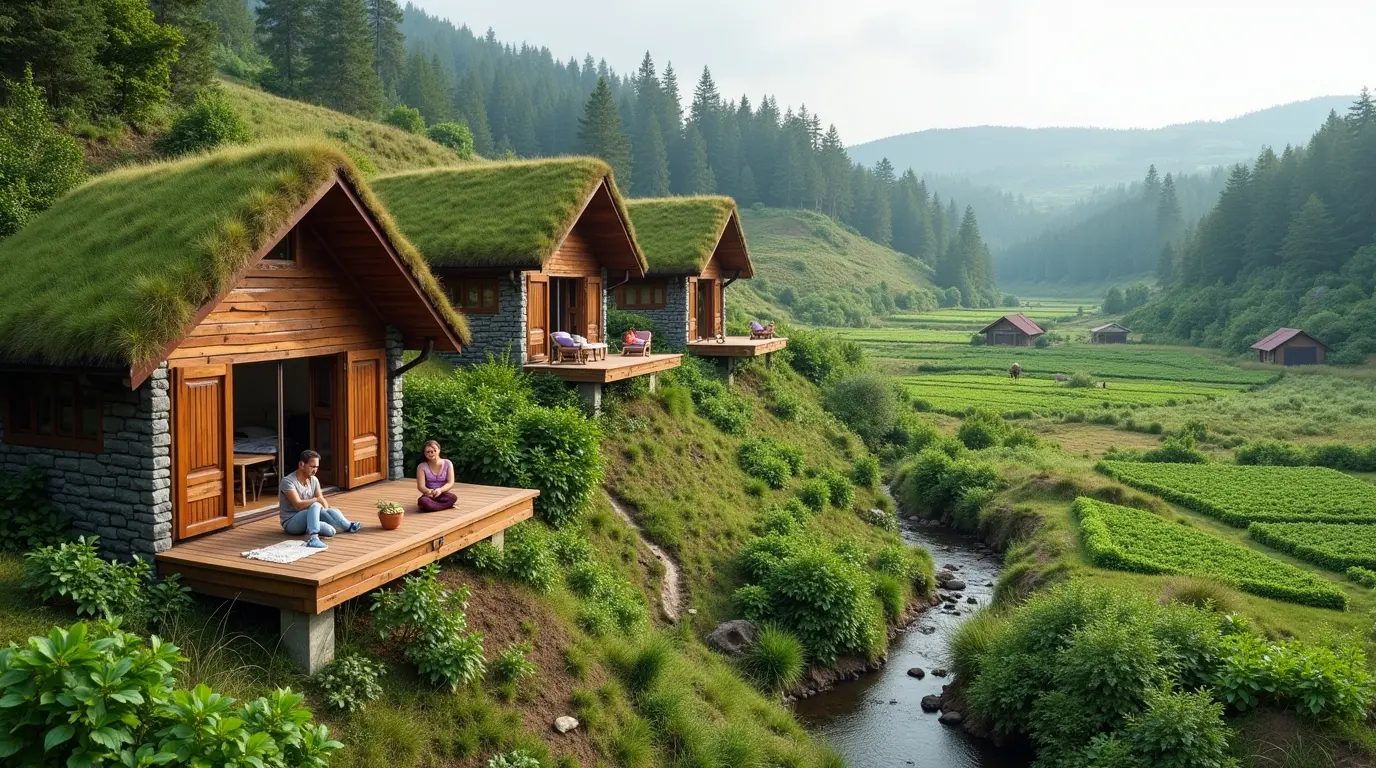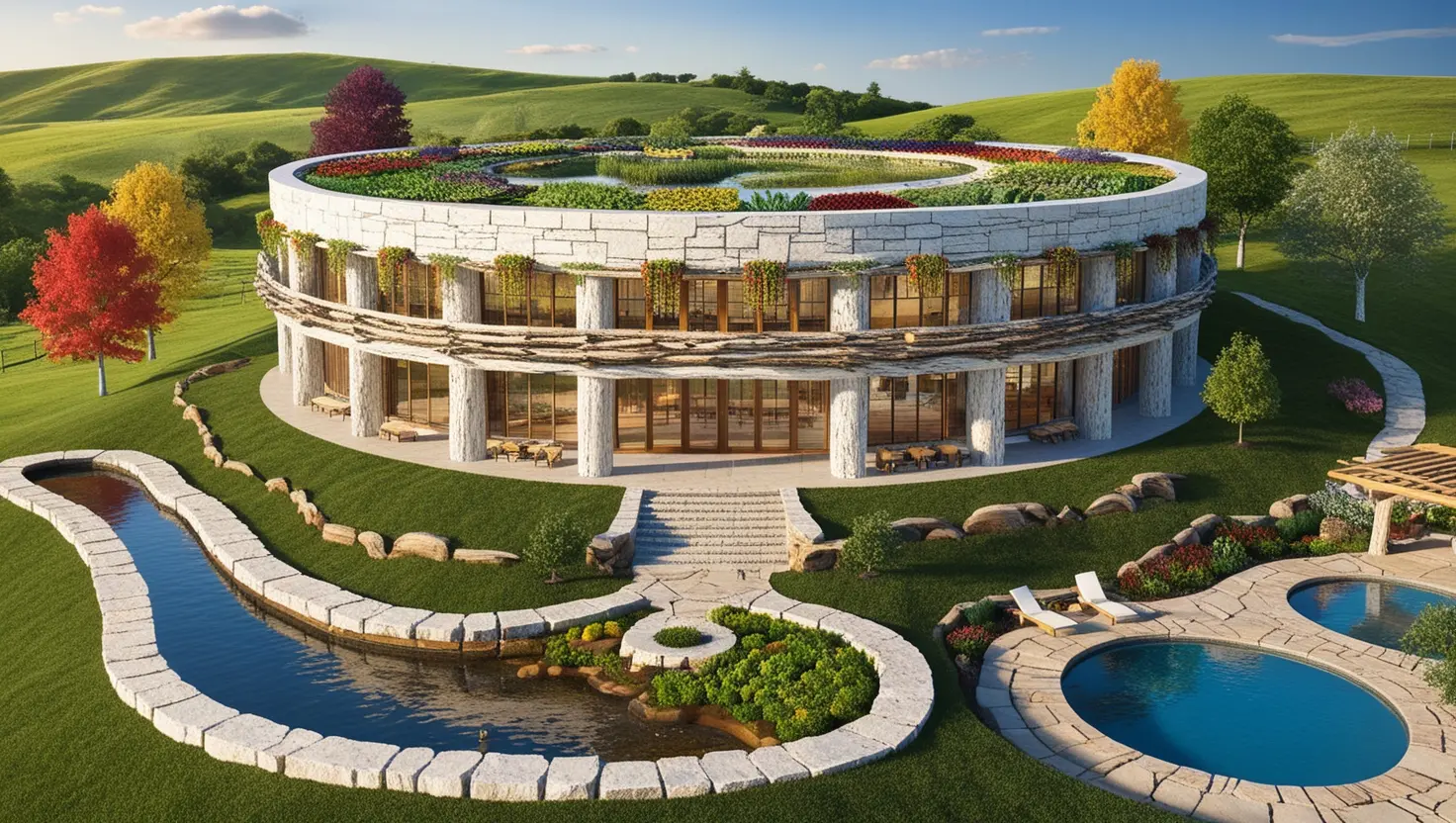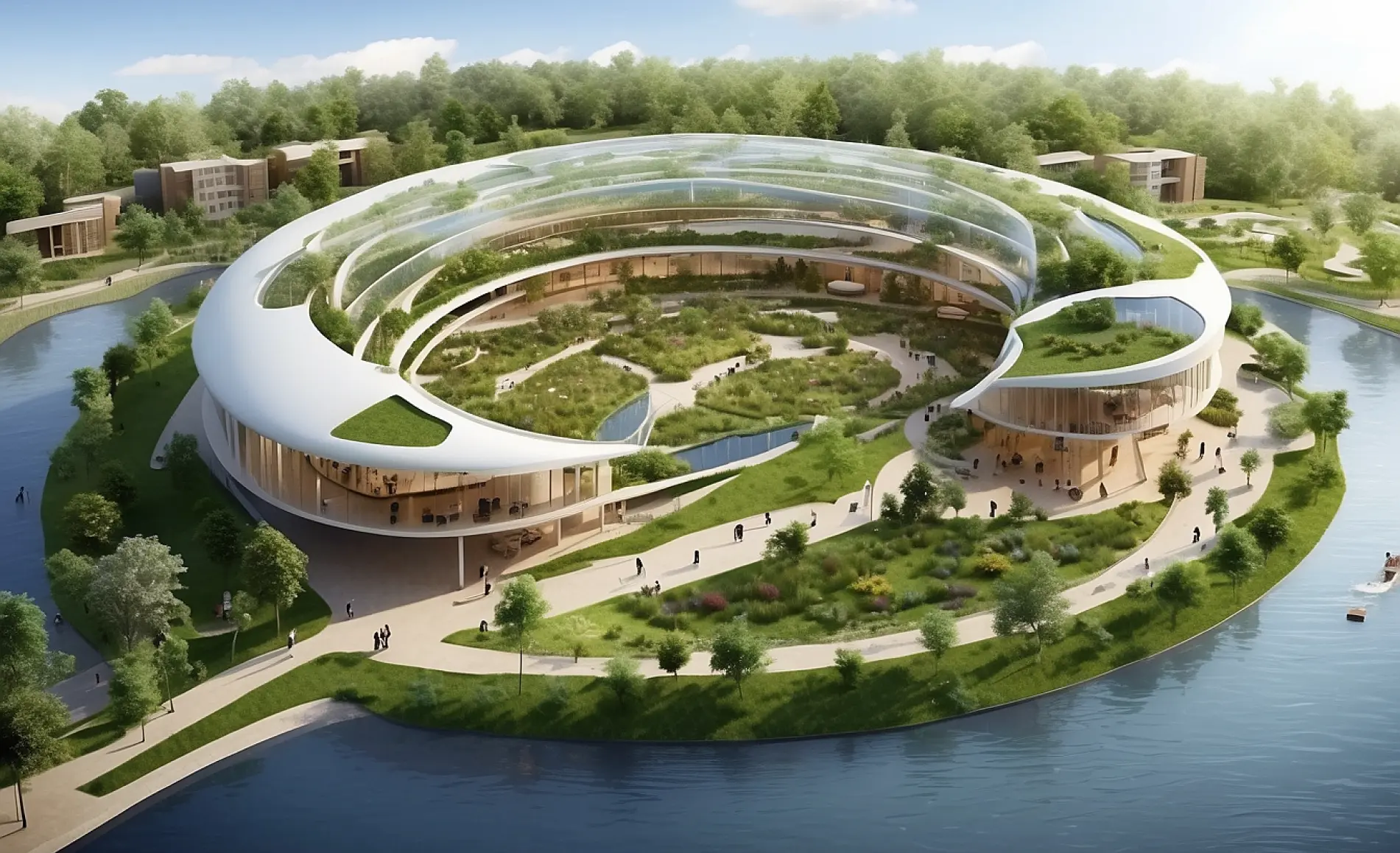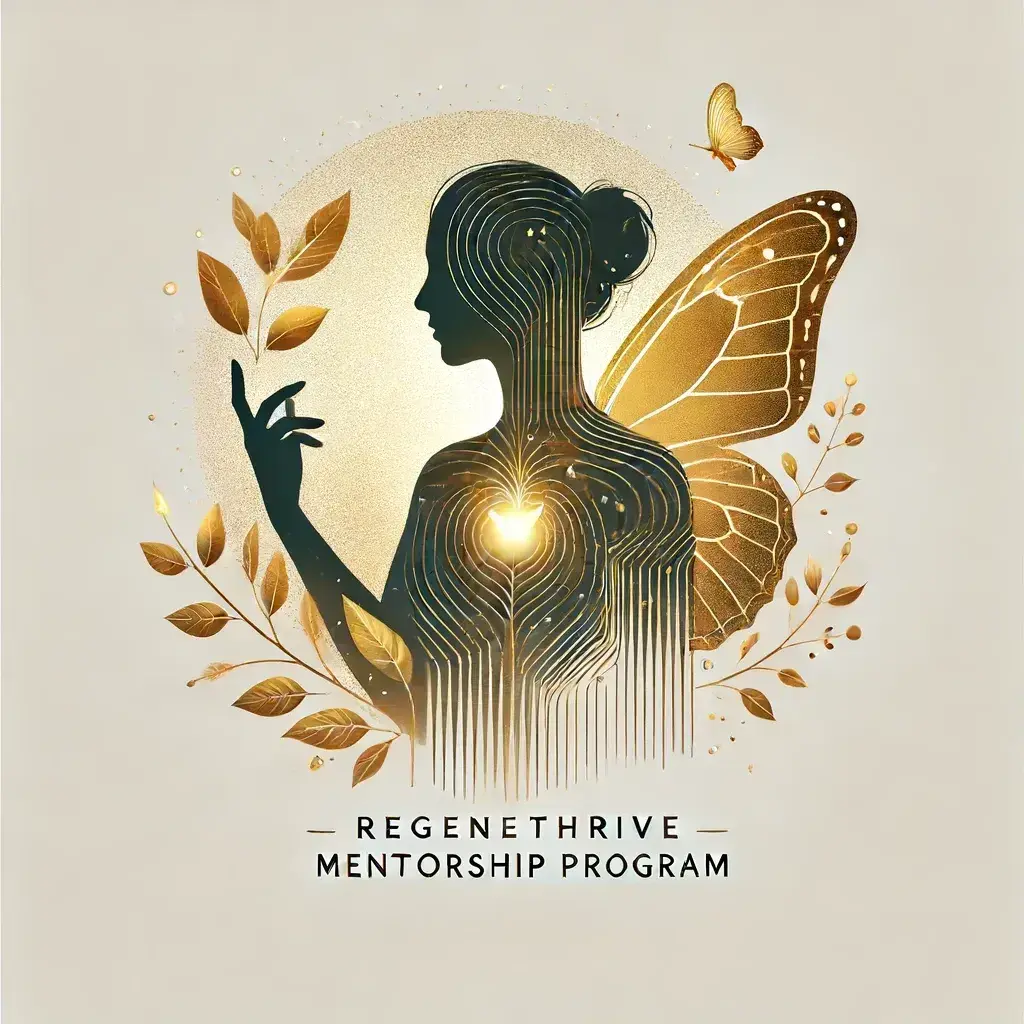Nature is the Original Master Architect
Throughout history, humanity has relied on natural and plant-based materials for shelter. What’s old is new again; only now, science validates what ancient wisdom always knew: building with plants and earth creates healthier, more resilient homes. In this era of climate urgency, these regenerative materials also serve as carbon sinks, waste reducers, and wellness enhancers. By embracing hemp, straw, bamboo, earth, and fungi, we shift construction from an extractive model into one that sequesters carbon, regenerates ecosystems, and supports human health.
Harmonious Hempcrete
Hempcrete is a mixture of hemp hurd (the woody core of the hemp plant) and a lime-based binder. The result is a lightweight, breathable, carbon-negative material that’s durable, fire-resistant, mold-proof, and pest-repellent.
- Carbon sequestration: Hemp actively absorbs CO₂ while growing, locking it into the structure for decades.
- Breathability: Regulates humidity naturally, improving indoor air quality.
- Durability: Resistant to fire, mold, and insects due to the lime binder.
- Applications: Non-load-bearing insulation infill, walls, and retrofits.
Best suited for temperate to warm climates, hempcrete excels in eco-villages, homes, and wellness facilities where air quality and comfort are prioritized.
Old School Straw Bales
One of the oldest and simplest materials, straw bale construction uses tightly compacted bales of straw as walls.
- Thermal mass: Dense pockets of air create exceptional insulation—sometimes outperforming hempcrete.
- Affordability: Agricultural waste is repurposed, making it inexpensive.
- Natural fit: When plastered with lime or clay, straw bale walls are fire- and pest-resistant.
- Longevity: With proper care, straw bale homes can last over a century.
Straw bale building is best in dry or temperate climates but can be adapted with good design in wetter regions.
Rammed Earth, literally.
Rammed earth uses compacted soil (with stabilizers like lime or cement) to form massive structural walls.
- Durability: Ancient rammed earth structures still stand after centuries.
- Thermal comfort: Thick walls store heat by day, release it at night.
- Local sourcing: Soil is often available onsite, reducing transport impact.
- Natural beauty: Earth tones and striations create aesthetic appeal.
Ideal for arid and semi-arid climates, rammed earth excels in eco-conscious communities and luxury sustainable builds.
Bountiful Bamboo
Bamboo is the fastest-growing woody plant, reaching maturity in just 3–5 years. Stronger than steel by weight, bamboo is widely recognized as the “green steel” of construction.
- Renewable: Regenerates quickly without replanting.
- Strength: High tensile strength, suitable for structural beams and flooring.
- Flexibility: Withstands earthquakes better than rigid materials.
- Low impact: Grows abundantly with minimal inputs.
Bamboo thrives in tropical and subtropical regions, supporting regenerative housing, resorts, and infrastructure.
Magical Mycelium
The future is fungal. Mycelium, the root network of fungi, can be grown into bricks, panels, or composites.
- Biodegradable: Fully compostable at end of life.
- Customizable: Grown into specific forms in molds.
- Insulation & strength: Lightweight but durable, fire-resistant, and pest-proof.
- Circular economy: Uses agricultural waste as substrate.
Though still emerging, mycelium is a breakthrough biomaterial that could replace plastics, foams, and even concrete for certain applications.
Comparison Chart: Plant-Based Materials
| Feature | Hempcrete | Straw Bales | Rammed Earth | Bamboo | Mycelium |
| Carbon Sequestration | High (hemp growth) | Moderate (waste reuse) | Low (neutral) | High (rapid regrowth) | High (bio-based) |
| Strength | Moderate (non-structural) | Good (insulative) | Very high (structural) | Very high (structural) | Moderate (panels/blocks) |
| Fire Resistance | Excellent | Good (when plastered) | Excellent | Good | Excellent |
| Mold/Pest Resistance | Excellent (lime binder) | Good (with plaster) | Excellent | Good (natural oils) | Excellent |
| Best Climate | Temperate/warm | Dry/temperate | Arid/semi-arid | Tropical/subtropical | Emerging/all climates |
| Cost Efficiency | Mid | Low | Mid | Mid | Emerging (varies) |
| Environmental Impact | Very low | Very low | Low | Very low | Very low |
| Applications | Infill, walls, retrofits | Full walls, eco-homes | Structural walls, luxury eco | Frames, floors, beams | Panels, insulation, blocks |
Noteworthy Engineered & Recycled Options
While not pure plant-based systems, hybrid and recycled materials are also changing construction:
- Grasscrete: Permeable concrete grid with grass growing through, reducing runoff and increasing green cover.
- Recycled Plastic: Durable, versatile, and a way to turn waste into housing components.
- Hemp Fiberboards: Eco-friendly drywall alternatives using hemp’s strength and lightness.
These serve as complements to plant-based systems, broadening the palette of regenerative choices.
Why Plant-Based Building Matters
- Carbon-negative construction: Hemp, bamboo, straw, and mycelium actively sequester carbon.
- Human wellness: Breathable, non-toxic materials improve air quality.
- Resilience: Resistant to fire, pests, and mold—outperforming wood.
- Economic empowerment: Materials can be locally grown, creating jobs in regenerative farming.
- Forest preservation: Every plant-based wall replaces lumber, protecting ancient ecosystems.
The Regenerative Blueprint
From hempcrete walls to bamboo beams and mycelium panels, plant-based materials are more than alternatives—they are the next evolutionary step in architecture. By shifting to these systems, we protect forests, sequester carbon, empower local economies, and create healthier spaces for humans to thrive.
Buckminster Fuller’s wisdom applies here too: “To change something, build a new model that makes the existing model obsolete.”
These natural models are already here. The question is: will we choose them now?
Follow me on LinkedIn for more RegeniThrive Reports, or connect directly through the Consulting tab on my website if you’re ready to integrate plant-based materials into your community or regenerative project.
This article is part of my RegeniThrive Report series on regenerative building materials and the urgent need to save our trees and forests. There is so much more to discover beyond what you’ve just read, each report highlights innovative solutions that allow us to build homes and communities without harming Nature and focuses on different options in each article. I invite you to explore the full series by visiting my blog at annanaturalista.com/blog, where I post new RegeniThrive reports each week. And if you are a community developer or simply ready to build your home or office with these regenerative materials, reach out to me directly so I can share the best sources and resources in your region of the world.
Together, we can co-create spaces that honor life while protecting our precious trees, the pillars of all life on our beloved planet.




















